#Gymnothorax funebris
Text
Wet Beast Wednesday: moray eels
This week on Wet Beast Wednesday I'll be going over something amazing, a fish with a sense of morality. You see, the moral eel is known for, what... I think I'm reading this wrong. Oh, MoRAY eel, not moral. Well this is awkward. Hang tight, I need to go redo my research.

(Image: a green moray (Gymnothorax funebris) swimming outside of its burry, with its whole body visible from the side. It is a long, slender fish that looks a bit like a snake. A long fin starts just below the head and continues down the length of the body. The body is arranged in a wave pattern. It has a pointed snout and small eyes. Its body is a yellow-green color. In the background is the sandy seafloor, dotted with various sponges and corals. End ID)
Moray eels are true eels, meaning they are in the order Anguiliformes. Yeah, I did wolf eels, electric eels, and lamprey eels before I got around to actual eels. There are over 200 known species of moray eel in 15 genera. Like other eels, they are elongated bony fish with extra vertebrae and reduced fins. Moray eels have fewer fins than most eel species, only having a dorsal, anal and tail fin that merge together and run down the back of most of the body and underneath portion of it. They achieve motion by undulating this long fin and sometimes undulating the rest of the body as well. Moray eels aren't the fastest of fish, but they can swim backwards, something almost no fish can. The head has a long snout with wide jaws. Most species have long fangs used to grab onto prey, but a few species are adapted to eat hard-shelled prey and have molar-like teeth to crush through shells instead. Probably the coolest feature of morays are the pharyngeal jaws. This is a second set of jaws located in the back of the mouth. When the eel bites onto prey, the jaws can be shot forward to grab the food and help pull it into the throat. While lots of fish have pharyngeal jaws, morays are the only ones who can extend their pharyngeal jaws forward and use them to grab prey. Morays have smooth, scaleless skin that is often patterned to provide camouflage. The skin is coated in mucus that provides protection from damage and infection. In some species, the mucus can be used to glue sand together to help reinforce burrows. Morays lack lateral lines, a system of organs found in most fish that senses changes in water movement. Their sense of smell is their primary sense. The size of morays varies between species. The smallest species is the dwarf moray eel (Gymnothorax melatremus) which reaches 26 cm (10 in) long. The largest species by mass is the giant moray eel (Gymnothorax javanicus) which can reach 3 meters (10 ft) and 30 kg (66 lbs) while the longest species is the slender giant moray (Strophidon sathete), the longest known specimen of which measured in at 3.94 m (12.9 ft).

New reaction image
(Image: a giant moray (Gymnothorax javanicus) emerging from a burrow. It is brown and mottled with yellowish patches. Its head is pointed at the camera and it's mouth is wide open, aming it look shocked. End ID)

(Image: an anatomical diagram of the skeleton of a moray eel emphasizing the pharyngeal jaws and the muscle attachments. End ID. Art by Zina Deretsky)
Moray eels are found throughout the Atlantic, Pacific, and Indian oceans. Different species are found in different temperatures and depths, though most species live in relatively shallow, warm water. Several species can live in brackish water and a few will swim upriver and live for a time in fresh water, though there do not appear to be any species that live their entire lives in fresh water. Morays are ambush predators who rely on the element of surprise. They live in small, tight places such as holes in coral, gaps between rocks, or sandy burrows. When prey passes, the eel can lunge out and grab it. Unlike most fish, the eel cannot use suction feeding due to the shapes of their mouths. They have to rely on lunging froward and catching prey with their mouths. Their mouths are adapted in shape to push water to the sides. This reduces water resistance and avoids creating a wave that could push prey away from the eel. If an eel catches prey that cannot be swallowed whole, it will tie itself in a knot while biting on to the food. By pulling its head through the loop, the eel can rip the food into bite-sized pieces. Spending most of their times in burrows also provides protection from predators, especially in juveniles or smaller species. At night, the eels will come out of their burrows to hunt sleeping prey while the larger predators are asleep. Giant morays have also been seen engaging in interspecies cooperative hunting with roving coral groupers (Plectropomus pessuliferus). The eels can fit into small crevices the groupers can't to flush prey into the grouper's path while catching their own. Morays are mostly solitary species and many can be territorial. They are known to be shy and will retreat into their burrows if they feel threatened. They are also curious and many species are quite intelligent.
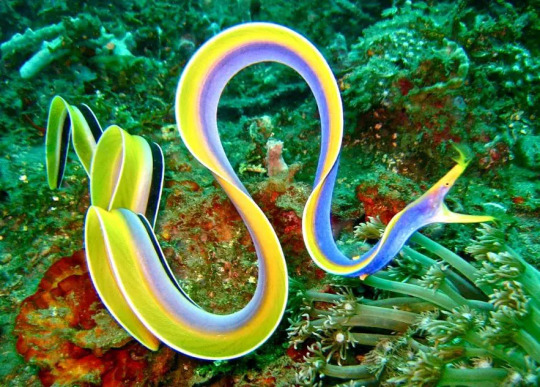
(Image: a male ribbon eel (Rhinomuraena quaesita) on a coral reef. It is a very long and slender eel with its body curved in many waves. It is brightly colored, with a blue-purple body, yellow fin and face, and a long black and white stripe running down the back half of the body. On the nostrils are two feather-like structures. End ID)
Morays reproductive strategies are poorly known and differ based on species. While many species seem to have no set mating season and will reproduce whenever they can, others will mate at the same time every year. Some species seem to have dedicated spots to lay their eggs and a few are believed to be anadromous, meaning they travel from the sea to fresh water to spawn. Meanwhile, some of the species that spend a lot of time in fresh water are catadromous, meaning they return to sea to mate. Females will lay their eggs and the male fertilize them. After this, they depart, providing no parental care. As with all true eels, moray eels begin life as leptocephalus larvae. This type of fish larvae is notable for its resemblance to a simple, transparent leaf with a head on one end. These larvae are unique and poorly understood, despite being the larval stage of a lot of different species of fish. They are unusually well developed for larvae, capable of active swimming and generally living life. In fact, some particularly large leptocephalus larvae were initially mistaken for adult fish. They feed mostly on bits of drifting organic material called marine snow and can remain in the larval stage for up to 3 years, with those in colder conditions usually taking longer to metamorphose. All leptocephalus larvae start out with no sex organs, then develop female organs, then develop male ones, becoming simultaneous hermaphrodites. They will ultimately become eith male or female and it is likely that environmental factors are the main determining factor. During metamorphosis into a juvenile, the leptocephalus can reduce in size by up to 90%, resulting in the juvenile being smaller than the larva. The process of maturation is poorly understood, but it seems that most morays will be sexually mature by three years of age.

(Image: multiple photos of a particularly large leptocephalus larva (not sure what species). It is a translucent organis, wth a body shaped like a very long leaf, narrow at both ends. In the frint is a very tiny head. End ID)
Morays are shy and generally avoid humans. Though some cultures have hunted them for food, they are often not considered a particularly good food source. Many species have high levels of chemicals called ciguatoxins in their bodies, which can lead to a condition called ciguatera fish poisoning if eaten. The largest threat to morays is habitat loss. This is especially true for the many species that live in coral reefs, which are in increasing danger due to global warming. Attacks on humans are rare and usually happen as a response to a human sticking their hand in the eel's burrow. Some of the large species could cause significant damage with a bite. Some species, usually the smaller ones, are found in the aquarium trade, thought they are not good pets for beginners as even the smallest morays are still large for aquarium fish and have some specific requirements. The curiosity many morays have has led to some becoming familiar with and even friendly to humans, often the result of feeding them. They can recognize individual humans and remember them over the course of years. Aquarium employees sometimes report that the eels will come to nuzzle and play with them and have personalities like dogs. Marine biologists and professional SCUBA divers Ron and Valorie Taylor befriended a pair of eels they named Harry and Fang at the Great Barrier Reef who would remember them and come out to visit them year after year.
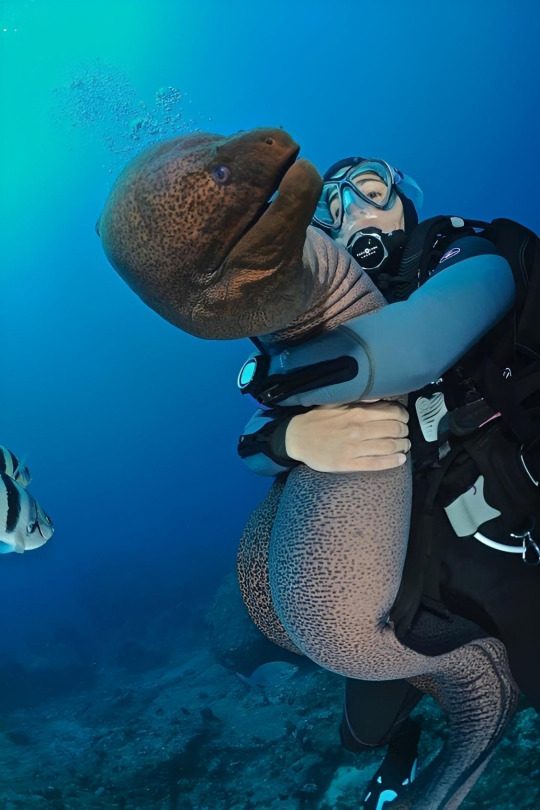
(Image: a SCUBA diver hugging a large, brown moray with black spots. End ID)
youtube
(Video: A shot video showing Valeria Taylor and a moray eel she befriended)
youtube
(Video: the song "That's a Moray", a parody of the song "That's Amore" by Dean Martin)
#wet beast wednesday#i accidentally typed moron eel more than once#moray eel#eel#anguiliformes#fish#bony fish#fishblr#fishposting#eelposting#marine biology#biology#ecology#zoology#animal facts#informative#image described#that's a moray#educational#Youtube
989 notes
·
View notes
Text
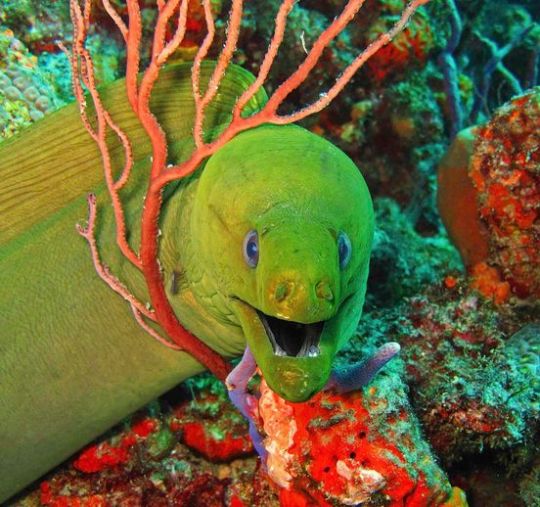
Green Moray (Gymnothorax funebris), family Muraenidae, off the coast of southern Florida, USA
photograph by @dohertyphotography
782 notes
·
View notes
Text

Eliot Rotford
Green Moray (Gymnothorax funebris) on Barracuda Reef in Fort lauderdale Florida
185 notes
·
View notes
Text

Green Moray (gymnothorax funebris)
105 notes
·
View notes
Text
Uncharismatic Fact of the Day
Contrary to the popular song Frank Sinatra song, moray eel eyes are actually quite small, and they have poor eyesight. To compensate, members of the Muraenidae family have two sets of nostrils; one pair just above their eyes, and a larger, tube-shaped pair towards the front of their face. The particular shape of their nostrils allows them to more accurately identify and locate prey. Now that’s a-moray!

(Image: A green moray eel (Gymnothorax funebris) by the Bournemouth Aquarium)
If you like what I do, consider leaving a tip or buying me a ko-fi!
142 notes
·
View notes
Text
day 66, 29/03/24 - fish f the day is the green moray (Gymnothorax funebris)

21 notes
·
View notes
Note
//O M G so I love your eel ideas and now I have to tell you mine.
Smartass: California Moray (Gymnathorax mordax) because they're brown, toothy, have goldish brown eyes and while its rare they have attacked humans and left puncture wounds. They have a pharyngeal jaw, which is an extra set of jaws that come out from the back of their head to drag prey to their throat. They also enter symbiotic relationships with shrimp and that works with Smartass' "you scratch my back, maybe I'll scratch yours" mentality. He's patient and intelligent if not slightly viscious.

Greasy: Green Moray (Gymnothorax funebris) Like Smartass he also has a pharyngeal jaw but is freakier and creepier with it. He is a cooperative hunter and will often follow anyone who is slightly better at it than him so he can have his share of the spoils. His goal is to mate as much as possible and have loads of his little descendents swimming the seas. Only problem is no female moray will choose him. But like most morays, he will wait until game comes to him. POV: You're a female moray minding her own business and this guy tries to charm you.

Wheezy: Wolf Eel (Anarrhichtys ocellatus) While not technically an eel (though don't bring this up to him he'll snap your fingers off) he's a valued asset because of his formiddable jaw. He's incredibly patient and a sharp shooter with his tail, curling into an S shape for his attack. Wolf eels are actually very curious and good at hiding. They also make good parents and mate for life. They are hunters from Day 1. Also as they age they turn browner or olive green and their pattern is somewhat smokey.
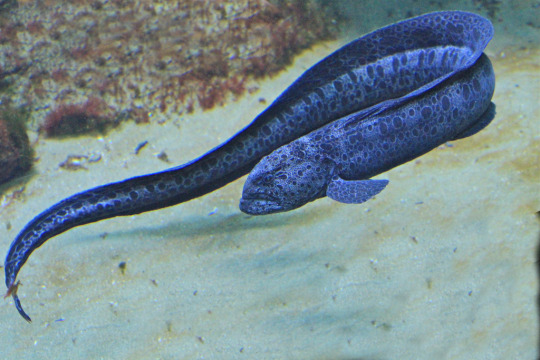
Psycho: Shortfinned cutthroat eel (Synaphobranchus brevidorsalis) they're long bottom feeders and efficient hunters who love their food and will also eat dead matter. At first I was going to make him an electric eel because his weasel version probably had electro-shock treatment but then I remembered they're freshwater so he wouldn't be able to live in the sea but the cutthroat species communicate through electrical organ discharges. Also the name was just perfect. Alternatively he could be a conger eel because they're adorable but toothy!


Stupid: I'm going to agree with you and say Spotted Moray (Gymnothorax moringa) I was originally going to go with a larger conger variety but if we go by the headcanon that Smartass and he are "brothers" they should look a bit similar. Especially the ones that have kind of that goofy look on their face. They are active during the day, are usually solitary and shy and like to eat crabs. Stupid's jaw at the back is worn out a bit from being too overexcited when grabbing crustaceans. Keeping them is imoractical due to their size. Look at this unit!


Just gonna put this ask here, so anybody who reads this will see what you mean right away ^^ and don't worry about it!
I absolutely love all of these options! I gotta agree with them ^^ And I got to learn some new species too. I'm very intrigued by the wolf eel ^^
Ngl my favorite is Greasy. Just- ok let's analyze this real quick. Among animals, while the other males are duking it out trying to woo the females, a weaker but smarter male will find a way to sneak past them. And the female is so into it!! Here, it sounds like Greasy is indeed the more intelligent bachelor among Moray Eels. At least the most clever. But Greasy is such a creepy dick that the girls still pass him up! They pass up the chance of their descendants knowing how to survive because Greasy can't keep it in his pants! Greasy blocks himself! 🤣🤣
Also, that picture is just sending me. Imagining that eel as Greasy. And just... It looks so cute! Even though it looks like it's rearing to attack the cameraman XD @slashingdisneypasta would you be able to resist that face on Eel!Greasy? XD
#asks#fish AU#Mermaid AU#eels#animals#fish#marine#wfrr#Toon Patrol#Smartass Weasel#Stupid Weasel#Greasy Weasel#Wheezy Weasel#Psycho Weasel#who framed roger rabbit#disney#disney villains
10 notes
·
View notes
Photo
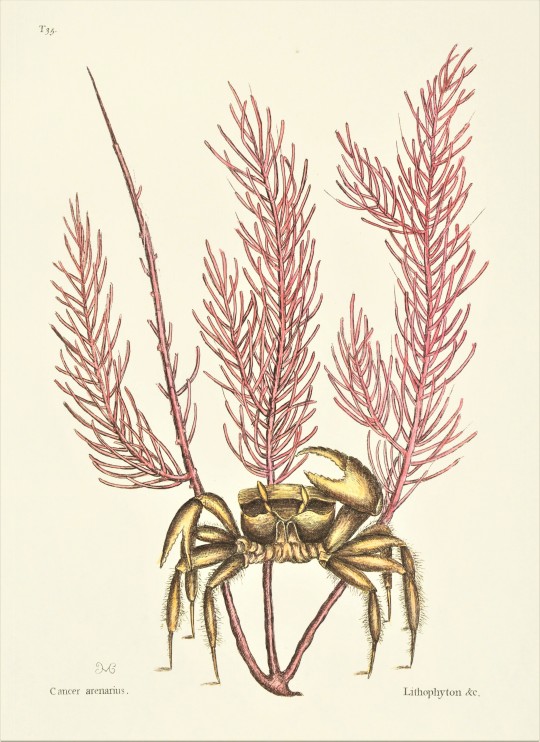
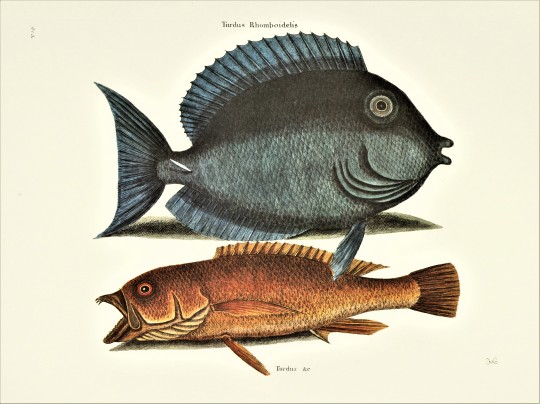



A Sea-Creature Science Saturday
We have featured quite a range of English Naturalist Mark Catesby’s avian specimens, but today we turn toward the sea. To be sure, both species of crabs shown above are terrestrial, but their lives begin in the ocean and they spend their lives Atlantic-adjacent, so we think it’s an acceptable grouping!
These plates come from our folio-sized facsimile of English Naturalist Mark Catesby’s The Natural History of Carolina, Florida, and the Bahama Islands, published in 1974 by Beehive Press of Savannah, Georgia in a limited run of 500 copies. It was designed and printed by The Stinehour Press in Vermont, and the fifty colored plates were printed at Meriden Gravure Company of Connecticut.
The plates above depict, from top to bottom:
Atlantic Ghost Crab (Ocypode quadrata), identified by Catesby as a Sand Crab (Cancer arenarius)
Upper: Atlantic Blue Tang (Acanthurus Coeruleus), called simply “the Tang” and classified Turdus Rhomboidalis by Catesby. Lower: Coney or Butterfish (Cephalopholis fulva), identified as “Yellow Fish” and classed as Turdus cauda convexa by Catesby.
Green Moray (Gymnothorax funebris).
Purple Land Crab (Gecarcinus ruricola), classified Cancer terrestris by Catesby.
Stoplight Parrotfish (Sparisoma viride).
You can read more about Mark Catesby and the making of his Natural History by reading our former intern Sarah’s post on the 1771 edition of The Natural History of Carolina, Florida, and the Bahama Islands.
More Catesby posts can be found here.
And find more Science Saturday posts here.
-Olivia, Special Collections Graduate Intern
#Science Saturday#Mark Catesby#The Natural History of Carolina Florida and the Bahama Islands#Natural History#Scientific Illustration#Etchings#The Beehive Press#Stinehour Press#Meriden Gravure Company#Ghost Crab#Blue Tang#Coney#Green Moray#Land Crab#Stoplight Parrotfish#olivia#facsimiles
73 notes
·
View notes
Photo

Green moray eel (Gymnothorax funebris) in the Cayman Islands
Giovanni Mari
276 notes
·
View notes
Video
youtube
5 notes
·
View notes
Photo

(Photo by Daryl Duda)
Green moray eel
#gymnothorax funebris#green moray eel#moray eel#moray eels#green moray eels#marine photography#eel#eels#underwater photography
118 notes
·
View notes
Text

My first lineless illustration♥ A Green moray eel♥ (Gymnothorax funebris)
#moray#moray eel#fish#watercolor#traditional art#sketch#eel#marine#wildlife#biology#art#lineless#pose#gymnothorax#gymnothorax funebris#green#green eel#green moray#green moray eel
3 notes
·
View notes
Text

Eliot Rotford
Green Moray (Gymnothorax funebris) on Oakland Ridges Reef in Fort lauderdale Florida
28 notes
·
View notes
Video
Green Moray Eels | Gymnothorax funebris
#Green Moray Eel#green#moray#eel#Gymnothorax funebris#saltwater#ocean#sea#marine#underwater#undersea#nature#aquaria#aquatic#underwater photoraphy#pair#aquarium#aquatic animal#beach#sand#coral reef#coral#reef#cave#cave dweller
40 notes
·
View notes

